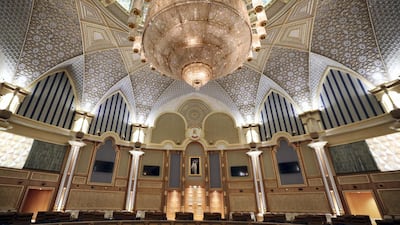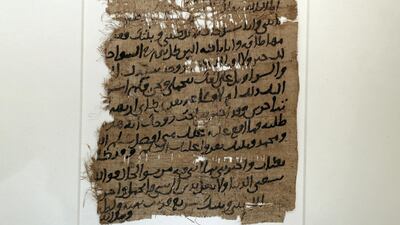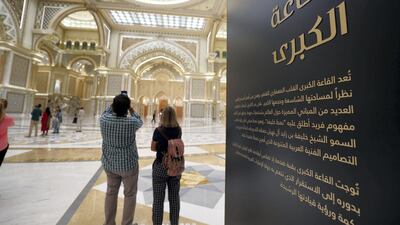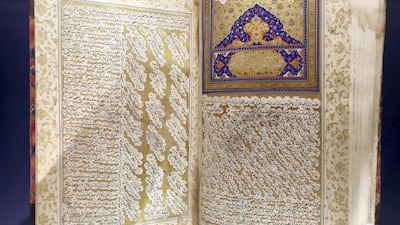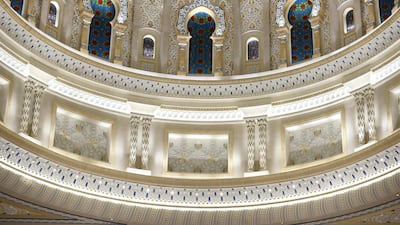It was a hidden world, a labyrinthine network of white domes, ornate buildings and gardens that were off limits to the public.
But the Presidential Palace, or at least part of it, opened to the public for the first time on Monday. And it was clear from the reaction of early visitors that Qasr Al Watan will be a huge attraction. Not only because of the architecture, precious manuscripts and sculptures but because it draws back the curtain on the rarefied world of a royal court.
Qasr Al Watan, or palace of the nation, is just one part of the sprawling Presidential Palace compound in Ras Al Akhdar that was handed over by contractors in 2015 and finished in 2017.
The palace houses the formal offices of the President, the Vice President and Crown Prince of Abu Dhabi and much of it still remains closed off.
But Qasr Al Watan alone makes the neighbouring Emirates Palace hotel seem like toytown - its façade of granite and limestone a blazing white in the afternoon sun, contrasting sharply with the blue of the sea that surrounds it.
The Great Hall
So what can visitors expect when they cross the threshold of this white edifice for the first time? There are ten zones for people to enjoy and all are contained within the Qasr Al Watan building.
The star of the show is undoubtedly the Great Hall, the architectural heart of Qasr Al Watan and where global leaders such as Chinese president, Xi Jinping, are feted. It measures 100 by 100 metres and its huge 37-metre diameter dome is even larger than the main dome of the Sheikh Zayed Grand Mosque.
The hall’s broader architectural style has flickers of Mughal-era design but it also incorporates classical local motifs such as the arch, dome and ornate tile-work. At each corner of the Great Hall stand four mirrored cubes where visitors can learn more about the architectural features. The "mirrors of reflection", for example, cast a light on the natural marble of gold, yellow and white used in the palace that aims to reflect the region’s landscape.
From the Great Hall, visitors have a choice of eight other rooms and if they come at night, can enjoy a daily light show with video projections thrown onto the building’s façade. But where Qasr Al Watan excels are the rooms that detail the day-to-day routine of royal life.
Take, for example, the room housing presidential gifts given to the UAE by countries across the globe. Carpets from Turkmenistan, an ornate sword and shield from Kazakhstan, armour from Japan and a beautiful khanjar from Oman all bring colour to the dry world of diplomacy.
Then visitors can walk just a few steps to the "spirit of collaboration" – a room designed to host summits of the Arab League and GCC. Above the circular table is a chandelier consisting of 350,000 crystals that weighs 12 tonnes. It had to be assembled in the room and even has space inside for a person to carry out repairs.
The Barza
When people have enough of the formalities, it is time for a royal banquet. Close to 149,000 pieces of silver, crystal and china were made for the palace and people can walk through a fully-prepared banquet hall. Plates are hand-painted, the food reflects the country where the host comes from, while tables at the front are half empty so guests do not turn their backs on the hosts. A popular meal served at these functions is quzi – an entire lamb sitting on a bed of rice.
Other rooms include al barza, or the majlis, where people can learn about the traditional ways sheikhs dispense advice, while another room is dedicated to rare manuscripts spanning several centuries. A lattice-inspired sculpture by Emirati artist, Mattar bin Lahej, also proved popular for selfies but one of the most unexpected of the ten experiences is a new public library. The collection spans at least 40,000 titles in Arabic and English and visitors can access this free of charge once they join the emirate's library service.
Qasr Al Watan is second major cultural attraction to open close to Abu Dhabi's downtown in the past few months. Qasr Al Hosn, Abu Dhabi's oldest stone building, reopened last year reviving the historic heart of the city.
“I have not seen anything like this grand structure even though I have travelled to many places,” said UAE resident Biju Oommen, who has lived in the country for eight years.
“We used to come to Emirates Palace and could see the building from there so we were curious to see what was inside,” said Mr Oommen, who is from India. “It has more than met my expectations.”
“We are excited to visit on the first day,” said Helen Eljamal, who was born in New Zealand but has lived in Abu Dhabi for 10 years.
"We are really excited so I’m sure tourists who come to the UAE will definitely want to see it.”
Ms Eljamal's friend, Cindy Kang, agreed.
“We have always wanted to see inside. It has really nice detail,” she said.
Qasr Al Watan is open seven days a week from 10am to 8pm and standard admission costs Dh60 either online or at the door. For more information visit www.qasralwatan.ae


